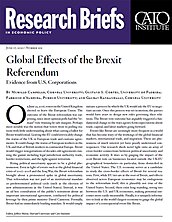Rising political uncertainty appears to be a global phenomenon. Even in light of events such as the global financial crisis of 2007–2008 and the Iraq War, the Brexit referendum brought about a pronounced spike in global uncertainty. That referendum was not part of an institutional mandate or predetermined political cycle (such as the election of new administrations in the United States). Instead, it was an ad hoc consultation of the public’s sentiment about an important international agreement, conducted for political leverage by then prime minister David Cameron. Formally, Brexit had no immediately binding mandate. It would simply initiate a process by which the UK would ask the EU to negotiate an exit. Once this process was set in motion, the parties would have years to design new rules governing their relations. The Brexit vote outcome has arguably triggered a fundamental change to the ways agents form expectations about trade, capital, and labor markets going forward.
Events like Brexit are seemingly more frequent in a world that has become wary of the workings of the global financial markets, international trade, and migration. These are phenomena of much interest yet have poorly understood consequences. Our research sheds novel light onto an array of cross-border connections between political uncertainty and economic activity. It does so by gauging the impact of the 2016 Brexit vote on businesses located outside the UK-EU geographical boundaries—in particular, firms domiciled in the United States. The U.S. economy serves as a candidate to study the cross-border effects of Brexit for several reasons. First, while EU ties are at the root of Brexit, and effects observed across European economies may be endogenous to the referendum itself, this is plausibly not true of the United States. Second, there exist long-standing, strong ties between the U.S. and UK economies, making potential outcomes more easily measurable. Finally, it is uniquely informative to look at the world’s largest economy to gauge the global impact of a consequential event like Brexit.
We begin our study on the potential firm-level externalities of events such as Brexit by sketching out a negative relation between uncertainty and fixed capital investment, divestitures, and employment growth, as firms have a greater incentive to wait and see before committing to these decisions. The framework predicts stronger effects on investment for firms with higher capital adjustment costs and stronger effects on employment for firms with higher labor costs. We also model the impact of uncertainty on growth-options activities, such as research and development (R&D) investing. We uniquely show how these activities are positively affected by aggregate uncertainty. The framework provides predictions for second-moment (uncertainty) shocks onto corporate decisions independent of changes to first-moment expectations (e.g., bad news).
We derive testable predictions to examine how UK-exposed firms in the United States (identified through market- and textual-search-based measures) conduct decisions regarding investment, divestitures, employment, and R&D spending in the aftermath of the 2016 Brexit vote. Using financial analysts’ forecast data, we find that there was no decline in the expected profitability of UK-exposed firms but an increase in profit dispersion—suggesting that Brexit embedded a second-moment innovation. We subsequently use an empirical approach that accounts for Brexit potentially having both first- and second-moment effects on U.S. firms. Our base estimates show that in the last two quarters of 2016 alone, the investment-to-assets rates, divestitures, and labor force growth of UK-exposed firms all declined compared to non-UK-exposed firms, while R&D investment increased.
We set out to characterize our findings on U.S. companies’ investment and employment decisions following the Brexit vote by identifying whether those decisions affected their U.S.-based operations or their foreign-based operations using establishment-level employment data. We find that investment cuts and jobs losses took place within U.S. borders. We further examine the workforce characteristics of the firms in our sample. Our tests show that workers with lower skills are most likely to be terminated by firms hit by UK-borne uncertainty. Brexit also affected UK-exposed firms’ establishment-turnover decisions, with the openings and closures of U.S. establishments falling by around 2 percent.
We finally delve into an analysis of offshoring activities in our sample firms. This analysis reveals that investment cuts are undertaken primarily by U.S. firms with a high degree of input (rather than output) offshoring activity with the UK. The evidence we present shows that the 2016 Brexit vote had a meaningful, multifaceted impact on the U.S. labor market.
We also find that, in keeping with our framework, the investment behavior of UK-exposed firms was modulated by capital adjustment costs. Specifically, the investment drop caused by the Brexit vote was a function of the nature of the assets that U.S. firms operated—it was more acute for firms in industries where fixed capital is highly irreversible (nonredeployable). Labor adjustment costs also seemed to modulate the extent to which UK-exposed firms hired and fired workers. In particular, exposed firms in industries with higher unionization rates—where workforce adjustments are costlier—registered a significantly lower job growth. Looking beyond investment and employment, we examine several auxiliary firm policies and find that UK-exposed firms also saved more cash and accumulated less inventory (noncash working capital) in the aftermath of the Brexit vote.
Through our analysis, we uncover the importance of U.S. firms’ input exposures, which drive the bulk of corporate investment cuts following Brexit. Our establishment-level employment data are further informative about how job destruction and establishment turnover operated inside U.S. borders in the aftermath of the 2016 UK vote. As the British anti-integration referendum has reportedly inspired similar national-centric movements in several other countries, it is important that researchers and policymakers are able to gauge its economic implications.
NOTE:
This research brief is based on Murillo Campello, Gustavo S. Cortes, Fabricio d’Almeida, and Gaurav Kankanhalli, “Global Effects of the Brexit Referendum: Evidence from U.S. Corporations,” NBER Working Paper no. 26174, January 2020, https://www.nber.org/papers/w26714.

